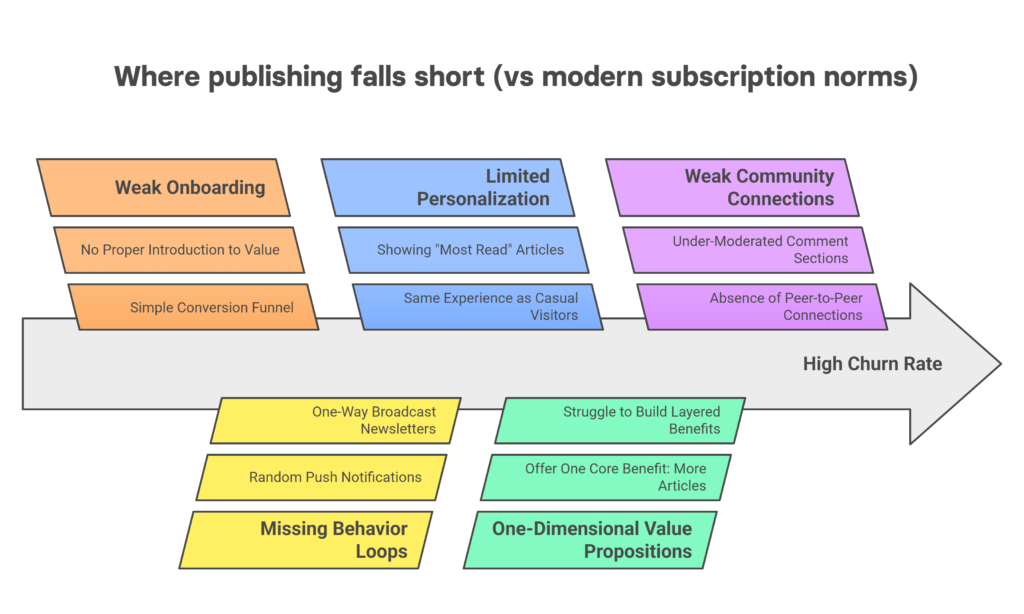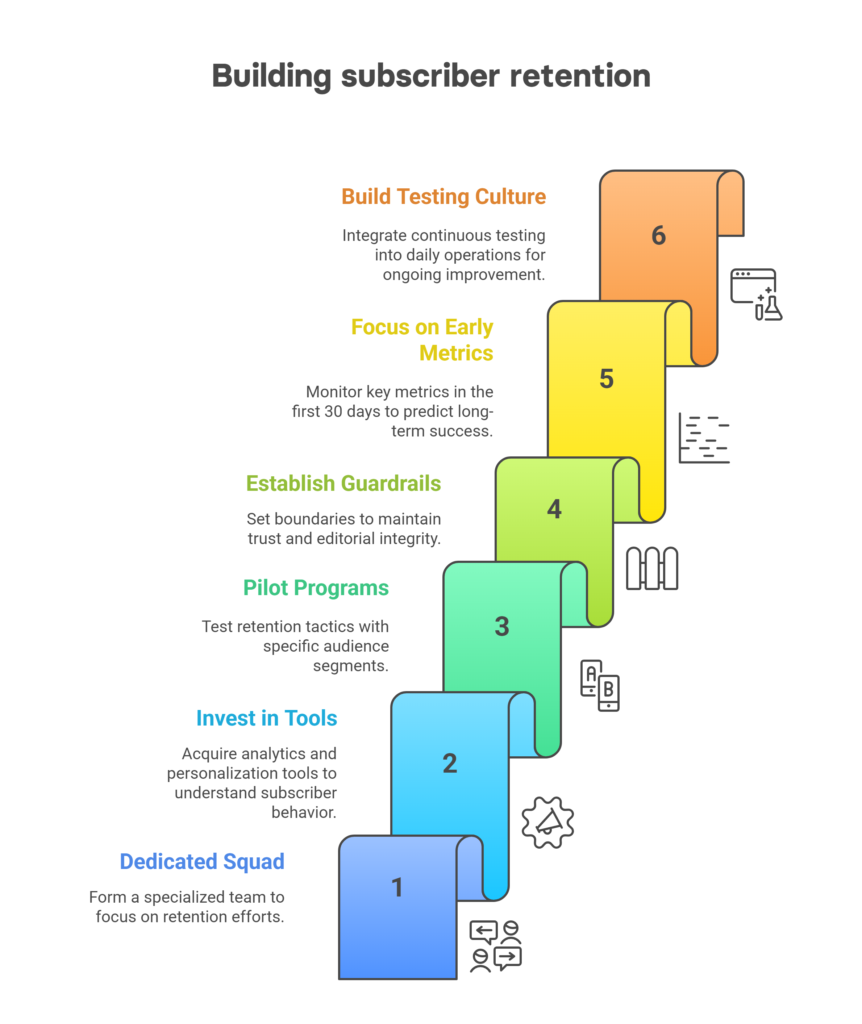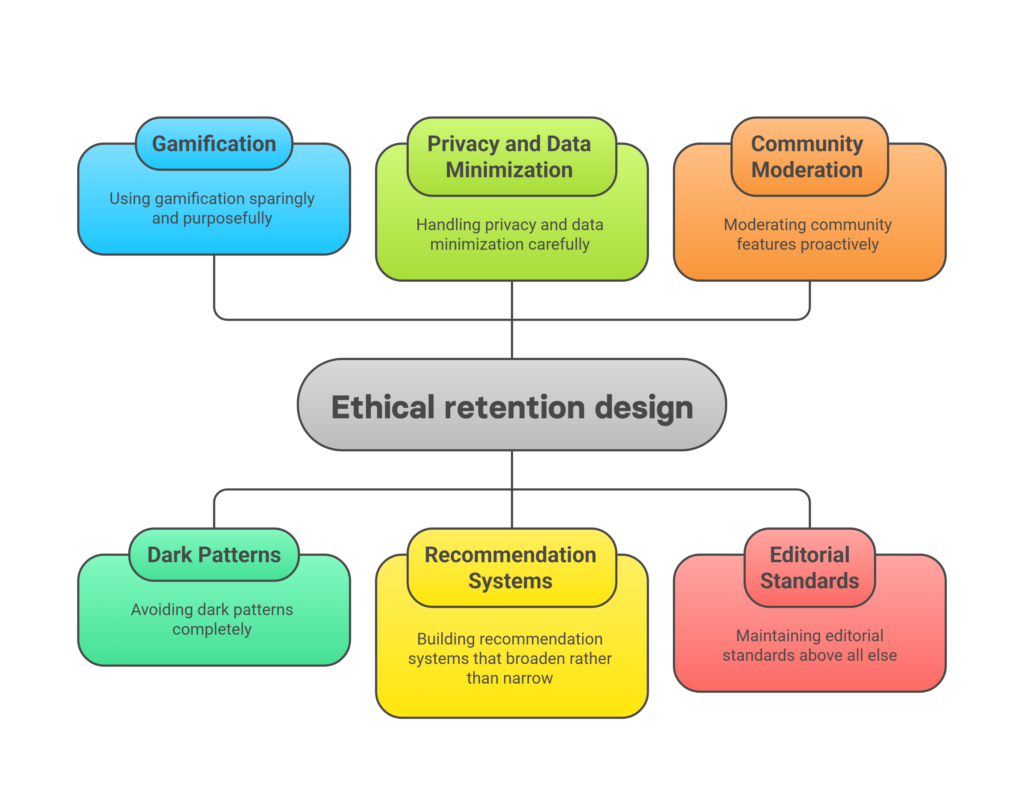For years, publishers have approached subscriptions like a race to the finish line. The goal was simple: rack up more sign-ups, achieve more growth, generate more revenue. But now reality is setting in, and it’s not pretty. The growth curve has flattened out completely.
The latest Reuters Institute Digital News Report delivers some sobering numbers. In wealthier markets, only about 18% of people actually pay for online news. That figure hasn’t budged in years, despite all the effort and resources publishers have poured into subscription drives. Meanwhile, the economics are getting tougher by the day. Research consistently shows that bringing in a new customer costs anywhere from 5 to 25 times more than keeping an existing one. For publishers, this creates a brutal reality: every subscriber who churns doesn’t just damage retention metrics. It wipes out months of expensive acquisition work.
But here’s the thing. When media executives get together to share war stories, they tend to stay trapped in their own echo chamber. The conversations revolve around which publisher has managed the lowest churn rate, who’s built the most effective newsletter funnel, or what paywall design proves stickiest. This inward focus creates a massive blind spot.
While news subscriptions have hit a plateau, other industries have been wrestling with the exact same challenges. The difference? Many of them are actually thriving. Fitness apps cracked the code years ago by understanding that keeping people engaged isn’t just about providing access to workouts. It’s about building habit loops and creating community accountability systems.
Productivity tools have become obsessed with perfecting their onboarding process, making sure users discover real value in their very first session. Gaming platforms use sophisticated progress tracking and streak mechanics to create long-term loyalty that keeps users coming back day after day. These aren’t cheap tricks or marketing gimmicks. They represent deliberate, tested retention strategies that successfully convert casual users into committed paying members.
The lesson here couldn’t be clearer. The most valuable retention playbooks aren’t being developed inside newsrooms. They’re being perfected in completely different industries. If publishers want to break free from their current dependence on constant, expensive acquisition, they need to look beyond their own sector. They need to study what works elsewhere, borrow those successful tactics, and figure out how to adapt them for journalism’s unique mission and constraints.
Where publishing falls short (vs modern subscription norms)
When you stack news subscriptions against the broader subscription economy, the gaps become painfully obvious. Publishers often treat churn as an inevitable cost of doing business, but other industries view it as a design flaw that needs fixing. The difference comes down to five critical areas where publishing habits lag behind modern subscription standards.

1. Weak onboarding hurts day-7 return rates
Most publishers treat onboarding like a simple conversion funnel: show a paywall, collect payment details, send a welcome email, then dump new subscribers straight into the content stream. Compare that approach to apps like Headspace or Notion, which use the first session to guide users through clear “aha moments” tailored to their specific needs.
In subscription businesses, those first seven days determine everything. Churn risk peaks if people don’t establish a habit quickly. Yet in media, too many new subscribers never receive a proper introduction to what makes their subscription valuable. Within weeks, they drift away because they never understood how to get the most from what they’re paying for.
2. Missing behaviour loops undermine habit frequency
The strongest retention engines don’t just rely on great content. They deliberately engineer reasons to return that feel natural and rewarding. Duolingo creates streaks that users don’t want to break. Peloton schedules live classes that build anticipation. Spotify delivers personalized playlists every Monday that become part of people’s weekly routine.
News publishers rarely build these structured loops. Push notifications often feel random rather than strategic. Newsletters become one-way broadcasts instead of interactive experiences. Daily reading rituals get left entirely to chance. This explains why visit frequency, which research shows is the strongest predictor of news subscription retention, remains so inconsistent across most publishers.
3. Limited personalization flattens engagement depth
Other subscription categories assume personalization is table stakes, not a nice-to-have feature. Netflix completely reshuffles its homepage based on viewing history. Calm recommends meditation sessions that match past preferences and mood patterns. These platforms understand that relevance drives deeper engagement over time.
In news, personalization typically means showing “most read” articles or basic topic filtering. New subscribers often get the exact same experience as casual visitors browsing for free. Without meaningful customization, early subscriber cohorts never develop the deeper engagement patterns that lead to long-term loyalty.
4. One-dimensional value propositions weaken retention elasticity
Fitness and wellness subscriptions aren’t just about accessing content. They bundle community features, achievement systems, exclusive events, and even physical merchandise that creates multiple reasons to stay subscribed. When budget pressures hit, cancelling becomes much harder because subscribers lose more than just content access.
News subscriptions typically offer one core benefit: more articles. When subscription fatigue strikes or household budgets tighten, “additional content” becomes a fragile defence against cancellation. Publishers who rely solely on editorial value struggle to build the layered benefits that make cancellation feel like a real loss.
5. Weak community connections erode long-term cohort performance
Most publishers still think community means comment sections, which are often under-moderated, occasionally toxic, and rarely habit-forming. Meanwhile, successful subscription apps embed social features as core retention drivers. Peloton builds leaderboards and group challenges. Gaming platforms create clubs and achievement sharing that keep players connected even during content lulls.
The absence of meaningful peer-to-peer connections explains why news subscriber cohorts often show steep decay after the first year. Without social bonds or community identity, there’s nothing holding subscribers when their initial enthusiasm for the content begins to wane.
Each of these gaps maps directly to retention metrics that publishers already know they struggle with. The frustrating part? Other industries have already cracked these problems. The real opportunity lies in adapting their proven solutions to fit journalism’s unique mission and constraints.
Lessons publishers can borrow
When you examine subscription leaders outside media, one thing becomes clear: retention isn’t left to chance. It’s methodically engineered. Fitness platforms, productivity apps, streaming services, and gaming companies build products that deliberately shape user behaviour, reward consistency, and weave community into their value proposition. The result? Subscriber cohorts that stick around, return regularly, and pay for much longer periods. Here’s what publishing can learn from their proven approaches.
Fitness and wellness apps are making progress visible
Peloton, Calm, and Headspace excel at transforming abstract goals like “get fitter” or “reduce stress” into concrete daily actions. They use streak counters, progress dashboards, leaderboards, and class schedules to give users tangible signals that improvement is happening. The community layer adds crucial accountability through features like Peloton’s in-class shoutouts or Calm’s shared meditation sessions.
Peloton has reported 12-month retention rates approaching 92% for connected fitness subscribers, an extraordinary figure in subscription economics.
Research across the fitness category shows that members who actively track performance metrics demonstrate 59% higher retention than those who don’t.
How publishers can adapt:
- Transform “daily reading” into visible streaks, such as “You’ve checked the morning digest 7 days running.”
- Build dashboards that reflect reader progress through topics followed, reading time accumulated, or stories saved for later.
- Use community recognition by highlighting active subscribers or showcasing reader comments in newsletters.
What to avoid: Don’t lean too heavily into gamification mechanics. News consumption isn’t a game, and retention features should amplify trust and credibility rather than cheapening the editorial experience.
Learning and productivity apps employ onboarding that creates immediate value
Duolingo and Notion obsess over making the first session count. They structure onboarding so users achieve a “quick win” immediately. Duolingo introduces simple exercises and celebrates small milestones, while Notion recommends templates based on user roles so people see personal relevance instantly. Dedicated retention teams continuously test and refine these flows.
Duolingo increased next-day retention from roughly 13% in 2012 to around 55% by 2021 through relentless iteration.
How publishers can adapt:
- Replace generic welcome emails with guided tours that let new subscribers choose beats and discover where to find value.
- Set achievable micro-goals like “Read three stories this week to unlock your personalized morning brief.”
- Run continuous A/B tests on onboarding flows, testing which welcome newsletter subject lines or app prompts improve day-7 return rates.
What to avoid: Don’t turn journalism into a checklist. Goals should guide people into sustainable reading habits, not make news consumption feel like homework.
Streaming platforms use recommendations as retention engines
Netflix and Spotify have mastered removing friction between users and their next piece of content. Autoplay features, personalized recommendations, and flexible subscription tiers keep users engaged across different contexts. The system isn’t just about volume; it’s about surfacing relevant content at exactly the right moment.
Around 80% of Netflix viewing comes through algorithmic recommendations.
How publishers can adapt:
- Build a “Because you read X” recommendation engine, but design for both depth and serendipity to avoid trapping readers in narrow information loops.
- Experiment with household subscription bundles or multi-user access plans.
- Use “read next” nudges in apps to maintain engagement momentum after each story.
What to avoid: Over-personalization can create dangerous echo chambers. Publishers need systems that balance individual relevance with editorial breadth and diverse perspectives.
Gaming & social platforms use events and community as loyalty anchors
Games like Fortnite and platforms like Twitch thrive on social connection. Limited-time events, seasonal content drops, and shared progression create compelling reasons to return that extend beyond core content. Peer interaction multiplies stickiness because when friends are active, individual users stay active too.
Epic Games reported that Fortnite’s in-game concerts attracted over 12 million concurrent players.
How publishers can adapt:
- Run exclusive “live news events” for subscribers such as real-time Q&As with reporters, expert AMAs, or election-night watch parties.
- Create seasonal content themes that build anticipation similar to gaming seasons.
- Build genuine peer connection through subscriber forums, private community spaces, or collaborative story annotation features.
What to avoid: Scarcity mechanics that work brilliantly in gaming can backfire in news contexts. Don’t build artificial “content drops” that compromise editorial seriousness. Focus on authentic community building rather than manufactured urgency.
A retention framework for publishers
So how do you actually pull all these lessons together into something actionable? Looking across industries, a clear pattern emerges. Retention isn’t the result of one clever feature or a lucky hit campaign. It’s built layer by layer, with each layer designed to solve a specific drop-off point in the subscriber journey.
Here’s what that framework looks like when you translate cross-industry best practices into a publishing context:
| Layer | What it looks like elsewhere | What it could look like in news | The retention lever |
|---|---|---|---|
| Onboarding & activation | Duolingo guides every new user to a “quick win” in their first session | A welcome tour that lets new subscribers pick beats, a default newsletter, and three quick reads on day one | Improves day-7 return and reduces early churn |
| Habit loop | Peloton builds streaks and scheduled sessions | A morning digest at the same time every day, light streak badges, or a “reading meter” that makes progress visible | Increases visit frequency (biggest predictor of renewals) |
| Personalisation | Netflix and Spotify serve tailored recommendations | A hybrid engine: “Because you read X” cards alongside editor picks | Lifts session depth and dwell time |
| Bundled extras | Fitness apps add tiers, perks, or merchandise | Subscriber events, partner discounts, archive access, or family/multi-user plans | Creates elasticity. Harder to cancel when budgets tighten |
| Community glue | Leaderboards, shared challenges, in-game clans | Reader forums, subscriber Q&As, contributor leagues, or featuring member comments in newsletters | Strengthens cohort stickiness and renewal rates |
| Metric focus | Retention squads track one hero metric (e.g. CURR) | A cross-functional team tasked with moving a single retention metric per quarter | Aligns product, editorial, and marketing around measurable gains |
The power of this model is that it gives every team a meaningful role. Editorial can own daily habits and community recognition. Product can design onboarding flows and recommendation systems. Marketing can test bundles and subscriber perks. Data teams can track cohort performance. Instead of everyone chasing pageviews in isolation, the entire organization rallies around improving one retention number at a time.
The sequencing matters too. You don’t need to launch everything simultaneously. Start with the foundation: create a guided welcome experience for new subscribers, establish a daily ritual they can count on, and build simple hybrid recommendations that make the next read obvious. Once those basics are working, add layers like exclusive events, subscription bundles, or community spaces.
Over time, these practices don’t just keep people subscribed. They compound into the kind of deep loyalty that no advertising campaign or one-off acquisition push could ever create. Publishers who master this layered approach will find themselves with subscriber bases that grow more valuable each year, rather than constantly leaking away.
Turning the framework into practice
Translating retention theory into newsroom reality requires more than smart ideas. It needs proper structures, the right tools, and consistent rhythms to make retention measurable and repeatable.
Here’s how publishers can start building that organizational muscle.

1. Create a dedicated retention squad
The biggest mistake is treating retention as “everyone’s job.” When that happens, it usually becomes no one’s priority. Leading subscription apps treat retention as a specialized discipline, and publishers should follow suit with a focused cross-functional team.
The ideal retention squad includes an editorial liaison who ensures newsroom buy-in and weaves subscriber engagement into coverage decisions. A product manager handles onboarding design, notification systems, and recommendation engines. A data analyst tracks cohort performance, runs A/B tests, and reports measurable improvements. Finally, a growth marketer owns nudge campaigns, subscription bundles, and win-back efforts for lapsed subscribers.
Keep it small but give the team clear ownership of one hero metric per quarter, whether that’s day-7 return rates, 30-day cohort survival, or annual renewal percentages.
2. Invest in tools that make retention visible
Retention work depends on seeing subscriber behaviour clearly and acting quickly when patterns emerge.
Publishers need three essential capabilities:
- Engagement analytics that track cohort curves, visit frequency, and content stickiness. Tools like Parse.ly, Chartbeat, or custom dashboards help teams understand which stories and formats drive sustained engagement versus one-time visits.
- Smart notification systems that segment audiences and schedule targeted alerts rather than blast generic messages to everyone. Research shows that well-targeted push notifications can double engagement for top news apps. The key is relevance and timing, not volume.
- Basic personalization infrastructure that combines algorithmic recommendations with editorial judgment. This hybrid approach makes the “next read” obvious without trapping subscribers in narrow content loops.
3. Start small with pilot programs
Don’t attempt to overhaul everything simultaneously. The smartest approach involves piloting retention tactics with one high-loyalty audience segment, such as politics subscribers, local sports fans, or lifestyle readers.
Design simple engagement loops that include improved onboarding, consistent daily touchpoints, and visible progress signals. Run these experiments for 6 to 8 weeks and track pilot cohorts against control groups. Quick feedback cycles matter more than immediate scale during these early stages.
4. Establish guardrails for trust and UX
Retention tactics only succeed when they enhance rather than erode credibility. Publishers need clear boundaries to protect editorial integrity.
- Respectful engagement means avoiding over-gamification that makes news feel trivial.
- Reading streaks and progress dashboards should feel meaningful, not gimmicky.
- Community moderation requires dedicated staffing because toxic environments drive churn faster than any algorithmic improvement.
- Editorial oversight ensures recommendation systems blend personalization with diverse perspectives to prevent dangerous echo chambers.
5. Focus on early-stage metrics that predict long-term success
Industry research shows the steepest subscriber drop-offs happen in the first 30 days, making this period crucial for measurement.
- Track day-1 activation by monitoring whether new subscribers complete key actions like logging in, choosing topic preferences, or opening welcome emails.
- Measure day-7 return patterns since early visit frequency strongly predicts long-term retention.
- Compare day-30 cohort performance between pilot groups and baseline subscribers, looking for improvements in churn rates, session depth, and renewal likelihood.
6. Build testing into daily operations
Every industry that has mastered retention, from fitness apps to gaming platforms, operates on rapid iteration cycles. Publishers who embrace this same experimental mindset will see steady improvements in subscriber loyalty over time.
The goal isn’t perfection from day one. It’s creating systems that learn, adapt, and compound their effectiveness as teams gather more data about what keeps subscribers engaged with quality journalism.
Risks, ethics, and guardrails
Borrowing tactics from fitness, gaming, or productivity apps only works if they strengthen trust rather than erode it. Here’s how to capture the benefits of modern retention design without importing the worst practices.

1. Use gamification sparingly and purposefully
Badges, streaks, and leaderboards can boost short-term engagement, but they can also push people toward “checking boxes” instead of finding genuine value. Research on gamification shows that effects are highly context-dependent and can backfire when mechanics overshadow the core purpose.
Design principle: Tie every retention mechanic to a clear journalistic outcome. “Complete our fact-check explainer series” works better than “keep your streak alive.” If a feature wouldn’t make a public editor proud, reconsider it.
Practical guardrails:
- Cap streak displays to show only the last 14 days and offer “rest days” so habits feel sustainable rather than compulsive.
- Celebrate knowledge mastery, like finishing a local elections guide, more than time spent reading.
- Test notification timing with deferral options, since research shows that timing choices dramatically change how reminders are received.
2. Avoid dark patterns completely
Design practices that make cancellation difficult, hide important choices, or manipulate users will damage relationships with readers and attract regulatory attention. The U.S. FTC has strengthened enforcement against deceptive subscription practices and high-profile cases have resulted in significant penalties.
Build systems that make exit simple because confident products don’t need to trap people.
Non-negotiables:
- Provide one-click cancellation from both web and mobile platforms.
- Use plain-language renewal terms without legal jargon.
- Never use pre-checked boxes or guilt-inducing copy during cancellation flows.
- Conduct annual user experience audits that specifically check for dark pattern risks in subscription, consent, and disclosure processes.
3. Handle privacy and data minimization carefully
Personalization and habit-building features require user data, which increases both legal and reputational risks if handled poorly. European regulations and growing U.S. state privacy laws demand careful attention to data collection practices.
- Purpose limitation: Only collect data that directly enables a reader benefit you can clearly explain.
- Real consent: Avoid bundled or “take-it-or-leave-it” consent for non-essential tracking. Privacy regulators warn against interface designs that steer people toward poor privacy choices, so keep consent options neutral.
- Automated decision transparency: When recommendations or content access relies on profiling algorithms, document the process and offer meaningful alternatives. GDPR requires clear explanations for automated decision-making that significantly affects users.
4. Build recommendation systems that broaden rather than narrow
Streaming-style recommendations can increase engagement depth, but news organizations have a responsibility to broaden perspectives rather than create filter bubbles. European regulations are moving toward requiring transparency in algorithmic recommendation systems, and readers increasingly expect clarity about “why am I seeing this?”.
Practical approach:
- Use hybrid systems that combine “Because you read X” suggestions with “Editor’s picks to broaden your view.”
- Include per-article explanations for why content was recommended.
- Conduct regular diversity audits of personalized feeds, checking for topic variety, geographic range, and source diversity, then share results internally.
5. Moderate community features poactively
Unmoderated community spaces damage trust faster than any retention improvement can restore it. Publishers need clear participation guidelines, dedicated staff moderation rather than just automated filters, and quality-focused metrics that prioritize meaningful contributions over raw comment volume.
Practical guardrails:
- Publish clear community guidelines and maintain consistent enforcement.
- Set service-level targets for staff responses during live Q&As or community events.
- Create separate workflows for handling sensitive news tips versus public discussion.
- Implement opt-in recognition systems like “top contributor” badges with transparent criteria.
6. Maintain editorial standards Above All else
When retention tactics conflict with editorial principles, editorial standards must prevail. Establish regular review processes with the editor-in-chief or standards editor for any feature that could manipulate emotions through scarcity timers, outrage-focused notifications, or sensationalized content promotion.
Document the intended reader benefit, success criteria, and conditions for discontinuing each retention feature before launch.
A quick ethics checklist before you ship any retention feature
- Reader benefit over metrics: Can we explain the subscriber benefit in one sentence that isn’t just “it increases engagement”?
- Informed choice: Can readers find, understand, and change this setting in under 30 seconds?
- Data minimization: Are we collecting only essential information, and for how long?
- Transparency: Do we explain why readers see specific content and how to adjust it?
- Easy exit: Can subscribers cancel, pause, or opt out in one step?
- Human accountability: Is there a named editor or community manager responsible for outcomes and quick reversals?
Design for loyalty, not lock-in. When retention systems leave readers feeling respected, informed, and in control, they build the kind of trust that becomes a publisher’s most durable competitive advantage.
Adapt, don’t replicate
If there’s one takeaway from examining fitness, productivity, streaming, and gaming industries, it’s this: retention equals growth. Publishers don’t need louder paywalls or increasingly complex acquisition funnels if new subscribers keep slipping away after a few weeks. What they need is a system that helps people find value quickly, builds sustainable reading habits, and creates multiple reasons beyond just “more articles” to keep coming back.
But here’s the crucial distinction: the goal isn’t to transform newsrooms into copies of Duolingo or Peloton. Those mechanics work within completely different contexts and incentive structures. Cross-industry models provide inspiration, not exact templates. The real work for publishers is translating the underlying discipline behind those successful models into practices that strengthen journalism rather than dilute it.
That means embracing an experimental mindset, not wholesale reinvention. Start small, design focused tests, measure actual impact, then build on what works.
- Examine your onboarding process first. Ask yourself: what meaningful value do new subscribers experience in their first 24 hours? Most publishers still dump people into the content stream without any guidance. Fix this foundational experience before adding complexity elsewhere.
- Form a small retention squad across editorial, product, and data teams. Give them ownership of one specific metric for the quarter, like day-7 return rates or 30-day cohort survival. When teams have clear, shared goals, retention stops being everyone’s responsibility and nobody’s priority.
- Launch a single habit-forming feature and measure its impact on subscriber behaviour. This could be a consistent morning brief that arrives at the same time daily, a simple “read next” recommendation system, or progress tracking that shows reading streaks. Test one approach thoroughly before adding layers of complexity.
The objective isn’t copying someone else’s growth tactics. It’s applying the same methodical approach that powers successful subscription businesses, but in service of trust, credibility, and quality journalism. Publishers who maintain this focus will build subscriber bases that compound in value over time, rather than constantly chasing platform algorithms or hoping for viral content to save the day.
When retention strategies work properly, they create a virtuous cycle. Engaged subscribers become advocates who recommend subscriptions to friends and family. They participate in community features that make the product more valuable for everyone. They provide feedback that helps editorial teams understand what coverage resonates most deeply. They become the foundation for sustainable growth that doesn’t depend on external platforms or economic conditions.
This approach requires patience and discipline. The results won’t show up in next month’s metrics. But publishers who commit to building these systems will find themselves controlling their own destiny in ways that no acquisition campaign or social media strategy ever could.







